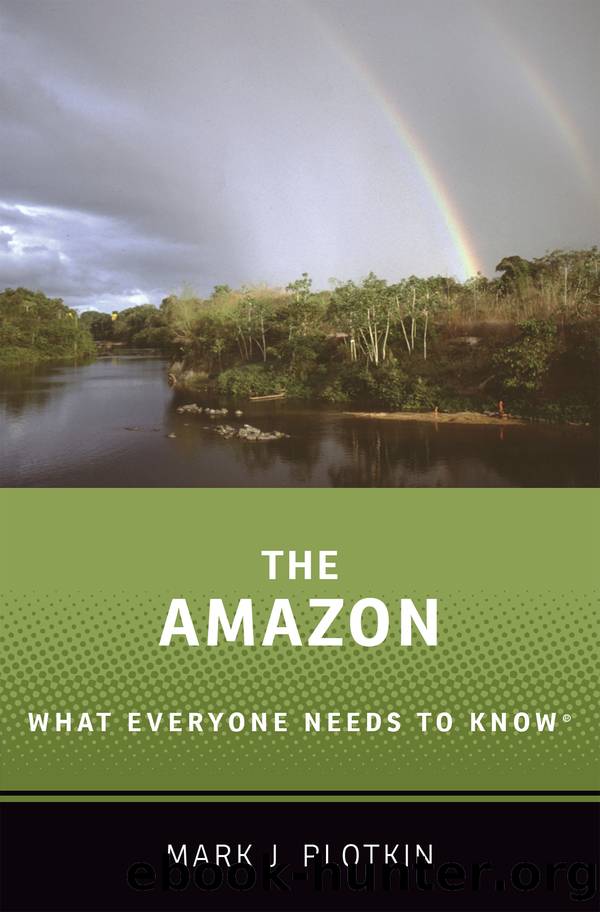The Amazon by Mark J. Plotkin

Author:Mark J. Plotkin
Language: eng
Format: epub
Publisher: Oxford University Press
Published: 2020-06-15T00:00:00+00:00
Do uncontacted and isolated tribes still exist?
The concept of uncontacted or isolated rainforest tribes enthralls many people, even those who have no other particular interest in tribal cultures or rainforest conservation. Ten years after they were published, people still recall pictures of red- and blue-painted Indians along the Brazil–Peru border attempting to keep the outside world at bay by firing arrows at a plane overhead.
Are these Indians truly uncontacted, or are they merely isolated? It seems fair and reasonable to rule out the existence of “undiscovered” or “lost” tribes. Anyone fortunate enough to live and work with relatively unacculturated indigenous peoples in the Amazon well knows that they are geographic masters of this challenging landscape—they do not get lost. And the question of “undiscovered” needs to be reasked: Undiscovered by whom? Columbus may have gone to his grave believing that he “discovered” America, but the Indians who were there to greet him would not have agreed.
Crucial to the discussion, therefore, is defining the term “uncontacted tribe.” If the last Karijona maloca (longhouse) in the Chiribiquete region of the northwest Amazon was seen in 1904, and longhouses are once again being spotted there from overflights in small planes, can we say with any degree of confidence that these people are Karijonas and that they therefore do not represent an uncontacted group? If a Colombian missionary met a tribe of isolated Indians near the Yari River more than 20 years ago and presented them with machetes and pots, and they then fled and he was unable to find them again, can we say that they have been contacted? If a single Trio Indian had a single encounter with two previously undocumented tribes, are those tribes considered “contacted”?
Many specialists prefer to refer to these people as “isolated” tribes, which avoids the semantic complications. And they live in isolation by choice: they are well aware that an outside world exists, but they choose not to join it.
One might wonder why these tribal peoples choose to remain in isolation. It may be an adaptive response to the many epidemics that swept through the New World with the arrival of the Europeans in 1492. In the western Amazon, however, this retreat into the deepest depths of the rainforest was to escape the depredations of the Rubber Boom, beginning around 1900.
The record of Westerners’ initiating contact to “help” or “save” these tribes has (for the most part) been a sad and sorry one. Fundamentalist American missionaries initiated contact with the Akuriyos of Suriname in the 1960s: within 2 years, one-third of the tribe was dead, including most of the people over 40 years of age. In a preliterate culture, the elders are the repositories of all tribal wisdom, knowing which plants are edible and which plants heal. Similar stories abound of tribes brought “in from the wild” who then take to their hammocks and die of respiratory diseases, depression, and/or culture shock.
Although there are recent reports of isolated tribes or groups from every Amazonian country except French
Download
This site does not store any files on its server. We only index and link to content provided by other sites. Please contact the content providers to delete copyright contents if any and email us, we'll remove relevant links or contents immediately.
| African-American Studies | Asian American Studies |
| Disabled | Ethnic Studies |
| Hispanic American Studies | LGBT |
| Minority Studies | Native American Studies |
Cecilia; Or, Memoirs of an Heiress — Volume 1 by Fanny Burney(31332)
Cecilia; Or, Memoirs of an Heiress — Volume 3 by Fanny Burney(30934)
Cecilia; Or, Memoirs of an Heiress — Volume 2 by Fanny Burney(30889)
The Great Music City by Andrea Baker(21313)
We're Going to Need More Wine by Gabrielle Union(18072)
Bombshells: Glamour Girls of a Lifetime by Sullivan Steve(13108)
Pimp by Iceberg Slim(12931)
All the Missing Girls by Megan Miranda(12747)
Fifty Shades Freed by E L James(12451)
Norse Mythology by Gaiman Neil(11883)
Talking to Strangers by Malcolm Gladwell(11876)
Crazy Rich Asians by Kevin Kwan(8349)
Mindhunter: Inside the FBI's Elite Serial Crime Unit by John E. Douglas & Mark Olshaker(7834)
The Lost Art of Listening by Michael P. Nichols(6472)
Enlightenment Now: The Case for Reason, Science, Humanism, and Progress by Steven Pinker(6405)
Bad Blood by John Carreyrou(5769)
The Four Agreements by Don Miguel Ruiz(5510)
Weapons of Math Destruction by Cathy O'Neil(5036)
We Need to Talk by Celeste Headlee(4868)
